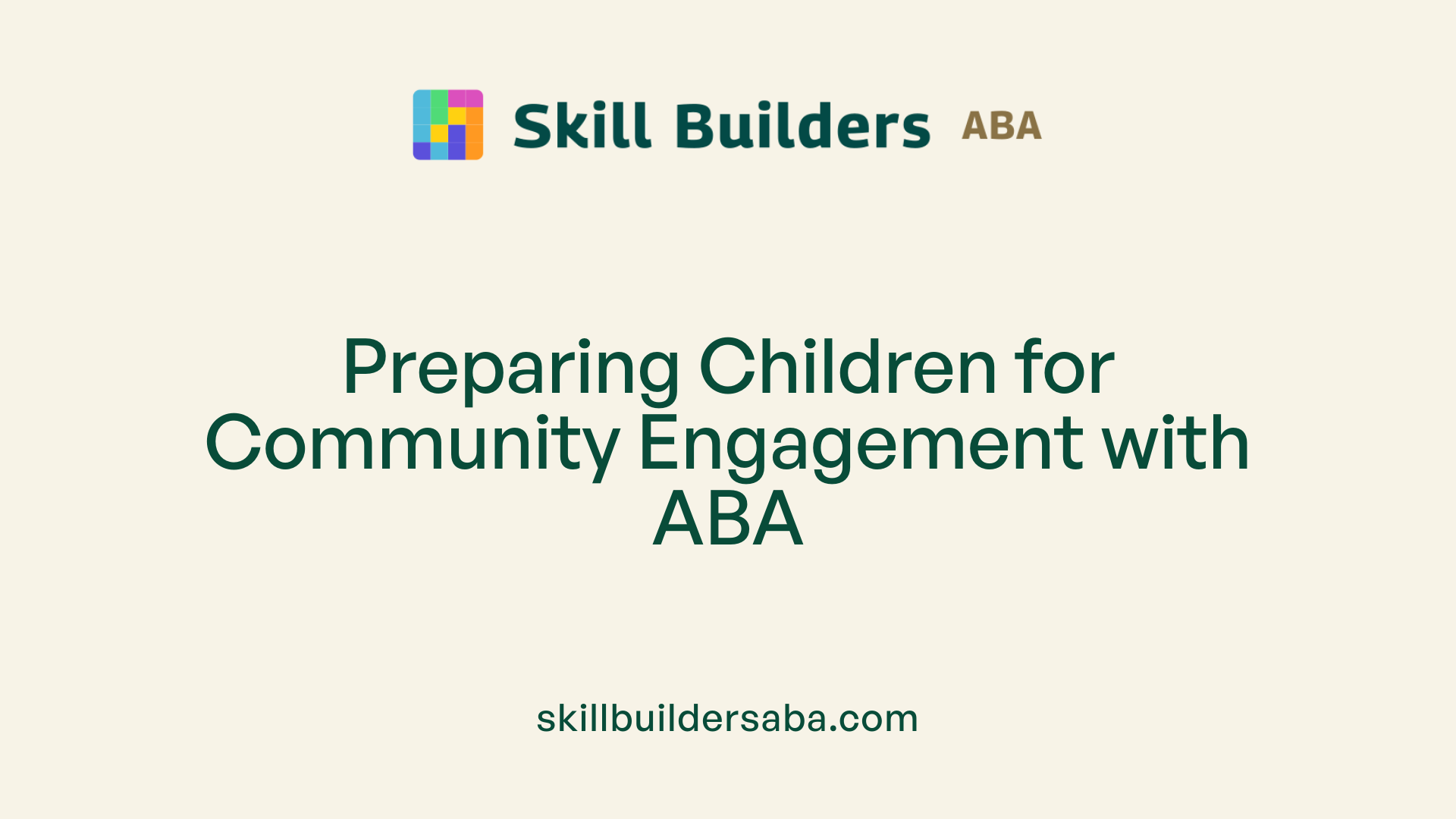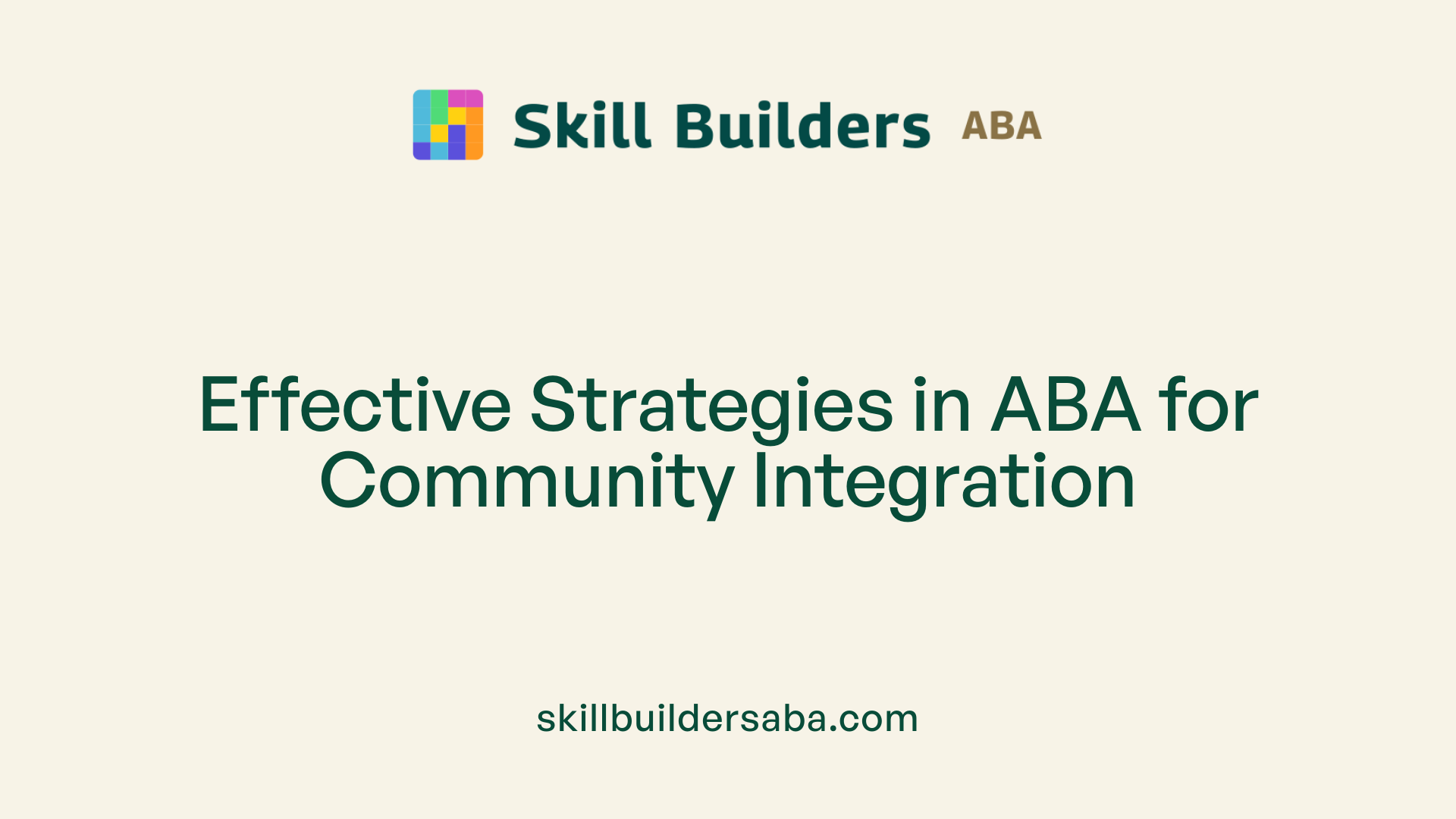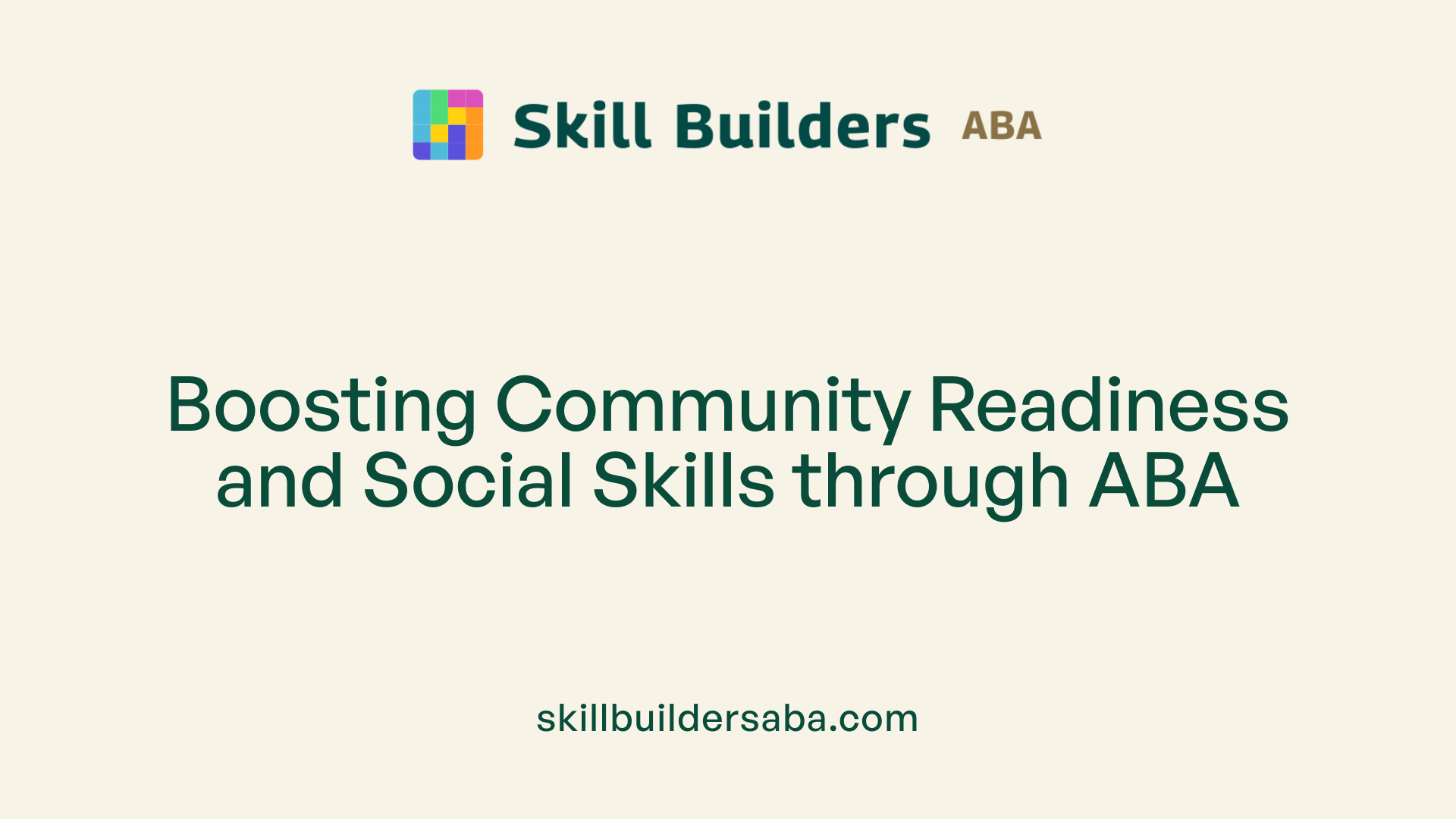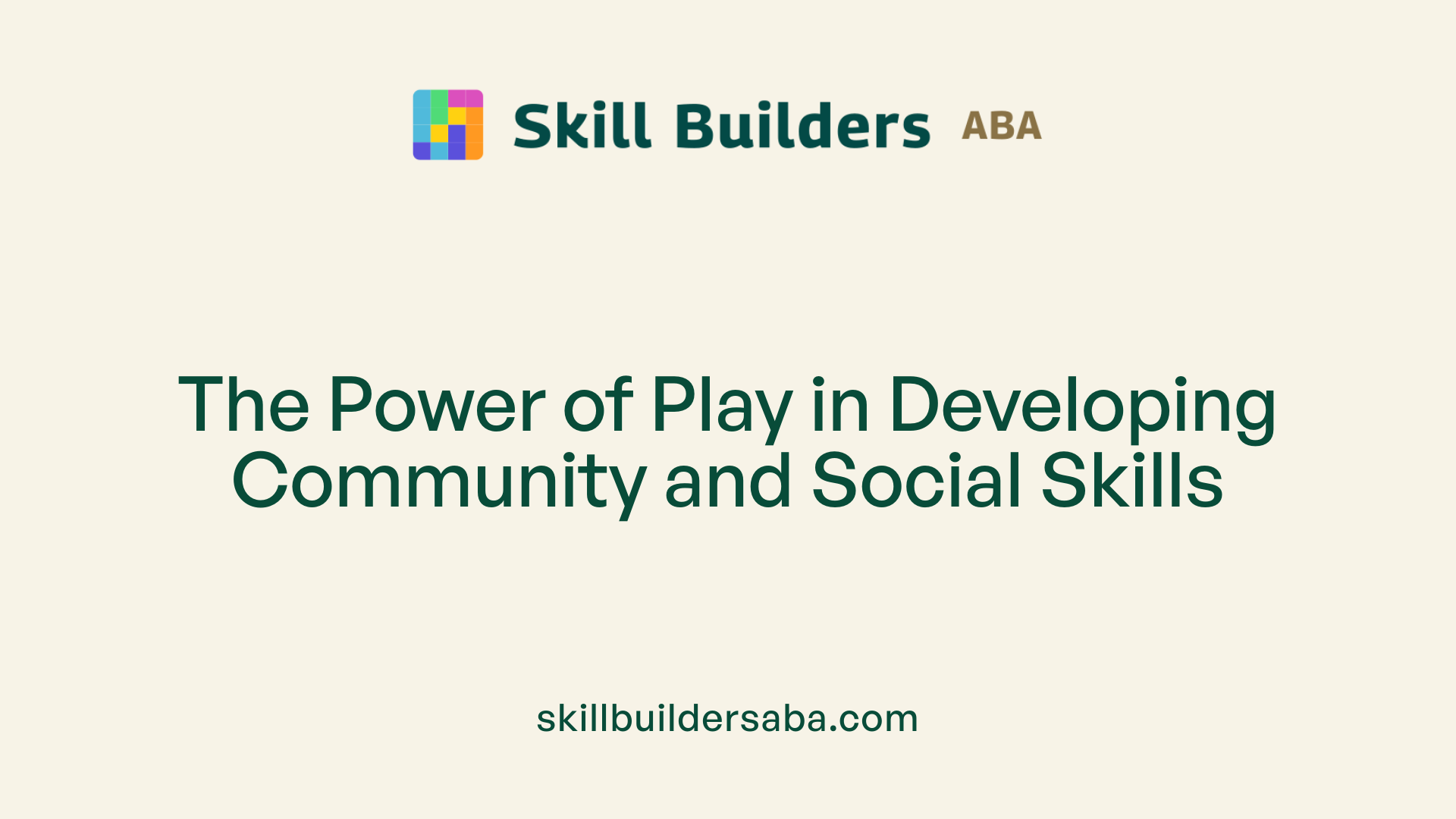
Building community readiness skills with ABA
Empowering Children with Autism Through Community-Centric ABA Strategies
Fostering Independence and Social Integration in Children with Autism
Applied Behavior Analysis (ABA) is a scientifically supported approach that helps children with autism develop crucial community readiness and social skills. By implementing structured, individualized interventions, ABA nurtures essential behaviors that enable children to participate actively in community life, from school settings to public environments. This article explores the methods, strategies, and benefits of ABA in fostering social participation, emphasizing the role of play and family involvement in creating meaningful community integration.
Understanding ABA's Role in Preparing Children for Community Engagement

How does ABA develop social skills in children?
ABA therapy plays a vital part in developing social skills by providing children with autism structured and repetitive practice of socially significant behaviors. This approach involves positive reinforcement when children demonstrate appropriate social interactions like sharing, turn-taking, and eye contact. Through systematic assessment and individualized teaching, ABA helps children understand social cues, develop peer relationships, and foster meaningful connections.
School-based ABA services extend these benefits by offering opportunities to practice these skills in natural environments. These services promote peer modeling, where children learn from classmates, and ensure consistency across different settings such as home, school, and community.
How does ABA improve communication and self-care skills?
ABA emphasizes enhancing communication abilities, aiming to help children effectively express their needs and desires. Strategies include teaching functional communication, label objects, and use visual supports like picture schedules. As children progress, they learn to understand verbal instructions and engage in reciprocal conversations.
Self-care routines such as toileting, dressing, and feeding are also core targets in ABA treatment. By breaking down these skills into manageable steps and reinforcing success, children build independence in daily routines, fostering greater confidence.
How does ABA build independence and confidence for community participation?
Through targeted interventions, ABA supports children in gaining the skills necessary for participating in community activities. This involves teaching skills like crossing streets safely, navigating public transportation, and engaging in recreational activities. ABA therapy aims to foster autonomy, which enhances confidence and readiness to explore and engage outside familiar environments.
Families and therapists work together to set achievable goals, ensuring that children not only develop essential life skills but also feel empowered to participate actively in their communities. This comprehensive approach leads to increased independence, improved self-esteem, and a higher quality of life.
| Aspect | Focus Areas | Support Strategies |
|---|---|---|
| Social Skills Development | Peer interactions, social cues, relationships | Peer modeling, social stories, role-play |
| Communication Skills | Expressing needs, language development | Visual supports, speech therapy, reinforcement |
| Self-Care & Independence | Toileting, dressing, daily routines | Task analysis, step-by-step teaching, reinforcement |
| Community Engagement | Navigating environments, social participation | Functional skills training, real-world practice |
Understanding how ABA fosters these areas highlights its role in setting children up for success in both community and school environments. Early, personalized intervention can result in lasting benefits like better academic outcomes, stronger social integration, and increased independence.
Strategies Used in ABA to Promote Community Integration

What methods and strategies are used in ABA to support community integration?
ABA therapy incorporates a variety of targeted methods to help individuals with autism and other developmental challenges successfully participate in community life. One fundamental approach is task analysis, where complex activities are broken into smaller, manageable steps, making them easier to learn and perform independently.
Social skills training plays a vital role, often utilizing role-playing, video modeling, and peer interactions. These activities help children practice social interactions, understanding social cues, and engaging appropriately in community settings.
Positive behavior support (PBS) and reinforcement techniques are also central. These methods encourage desirable behaviors by providing rewards or praise, reducing challenging behaviors, and promoting adaptive skills like sharing, waiting, and following directions.
Data collection and analysis are essential for effective ABA interventions. Regular monitoring allows practitioners to track progress, identify areas needing adjustments, and ensure that each strategy effectively fosters community participation.
Equally important is training educators and support staff in ABA principles. This ensures consistent implementation across different environments, enabling children to transfer skills learned in therapy to real-world situations.
How do these strategies improve community involvement?
Together, these approaches help children develop practical skills such as using public transportation, shopping, and engaging in social activities.
By emphasizing positive reinforcement and skill generalization, ABA promotes confidence and independence, making community activities more accessible and enjoyable.
| Strategy | Techniques | Goal | Implementation Details |
|---|---|---|---|
| Task Analysis | Chaining, breaking tasks into steps | Mastery of daily routines and community skills | Step-by-step instructions personalized to each child |
| Social Skills Training | Role-playing, video modeling | Improve social interactions and communication | Practice scenarios with peers or therapists |
| Positive Behavior Support | Reinforcement, praise | Increase adaptive behaviors, decrease problem behaviors | Immediate, meaningful rewards aligned with child interests |
| Data-Driven Adjustments | Ongoing progress monitoring | Tailor interventions for maximum effectiveness | Regular review of behavioral data and outcomes |
What is the importance of data-driven decision-making?
Using data allows therapists to evaluate what strategies are working and where adjustments are needed. This ensures interventions are personalized and adapt to the child's evolving needs. It also provides measurable evidence of progress, which motivates continued effort and supports goal setting for community inclusion.
How ABA Improves Community Readiness and Social Skills in Children

How does ABA therapy develop community readiness and social skills in children?
ABA therapy plays a vital role in developing social and community skills among children with autism and other developmental conditions. It teaches children to engage in socially meaningful behaviors such as sharing with peers, taking turns, and reading social cues that indicate emotions, intentions, or reactions. These skills are crucial for forming friendships and participating actively in group settings.
Structured activities like role-playing, which simulate real-life social situations, are used to practice and reinforce appropriate responses. Video modeling provides visual examples that children can imitate, while group activities promote peer interaction and collaborative play.
Beyond social interactions, ABA focuses on practical self-care skills, emotional regulation, and understanding routines both at school and in the community. These skills help children transition smoothly from familiar environments to new settings, fostering independence.
Customization is key; ABA programs tailor goals to each child's abilities and needs. This individualized approach builds confidence and social awareness, empowering children to participate comfortably and effectively in their communities.
In summary, ABA therapy equips children with the fundamental social skills and self-help strategies necessary for community engagement, improving their ability to connect and succeed in various social contexts.
The Contribution of ABA Principles in Building Community Skills

How do ABA principles contribute to fostering community readiness skills?
Applied Behavior Analysis (ABA) offers a structured approach to teaching children and individuals with developmental challenges essential community skills. Central to ABA are systematic assessments and personalized interventions that target socially meaningful behaviors, including communication, social interactions, and independence.
One of the fundamental principles of ABA is positive reinforcement, which motivates individuals to repeat desirable behaviors. When combined with natural environment teaching, this approach encourages learning in real-world settings, making the skills more applicable across different areas of life.
Modeling peer behaviors and using reinforcement within community settings, such as parks or stores, helps individuals practice skills in contexts similar to daily life. As they repeatedly engage in these behaviors, they learn to navigate social situations and routines confidently.
The use of data collection and analysis plays a vital role in ABA, allowing therapists and caregivers to monitor progress continuously. This information helps adapt and refine programs, ensuring that interventions are effective and tailored to the individual's evolving needs.
By fostering these skills through a consistent, evidence-based framework, ABA supports greater independence and social participation. These improvements promote fuller community engagement, deeper friendships, and a smoother transition into everyday settings.
The Role of Play in Developing Community Skills and Social Participation through ABA

What role does play have in ABA therapy for developing community skills and supporting social participation?
Play is a vital component of ABA therapy when it comes to teaching children with autism essential social and community skills. It offers a natural and engaging environment where kids can practice social behaviors like cooperation, communication, turn-taking, and emotional understanding.
Through play-based activities, therapists utilize methods such as modeling, shaping, and positive reinforcement to help children learn and master complex social skills. These techniques break down behaviors—like initiating interactions, recognizing facial cues, and respecting personal space—into smaller, manageable steps.
Activities such as role-playing, cooperative play, and storytelling with social stories are incorporated into sessions. These not only teach skills but also help children apply what they've learned across different settings, paving the way for successful participation in real-world community situations.
Building social skills through play also involves family and community as key partners. Reinforcing these skills outside of therapy is crucial for real-life application, whether in grocery stores, parks, or public transportation.
In conclusion, play functions as a motivating and practical approach within ABA to cultivate enduring social abilities. By making learning fun and relevant, children gain confidence and independence, empowering them to become active members of their communities and social circles.
Unlocking Potential: A Pathway to Inclusive Communities
ABA therapy stands as a powerful tool in developing community readiness skills among children with autism. Through structured interventions, positive reinforcement, and play-based strategies, children gain independence, social competence, and confidence to navigate diverse environments. The ongoing collaboration between therapists, families, schools, and communities ensures that these children are not just participants but active contributors to inclusive societies. Emphasizing early intervention, community involvement, and individualized treatment, ABA fosters a future where children with autism can thrive socially and functionally within their communities, paving the way for richer, more inclusive lives.
References
- Social Skills: Helping Children Build Meaningful Connections
- 5 Evidence-Based Benefits Of ABA Therapy For Children With Autism
- ABA Therapy: Benefits of Early Intervention for Lifelong Growth
- Unit 13: ABA and School Readiness: The Importance of Play Therapy
- ABA Therapy Goals: 25 Practical Examples & Timelines
- How ABA Therapy Helps With Social Skills
- Social Skills in ABA Therapy: Helping Your Child Build Friendships
- The Power Of Play In ABA Therapy - Willow Reach
- How ABA Therapy Helps Build Daily Living Skills | Dream Big
- 10 ABA Activities to Boost Your Child's Social Skills
Reach Out Today
Learn more about how we can support your child’s growth and development. Contact us to discuss our services and availability in your area.
.svg)